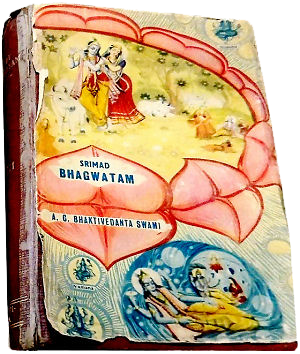LOVE FOR GOD
By Haripada dāsa
There is a spiritual book called the Mādhurya Kaḍambinī or the Nectar Clouds of Śrīla Viśvanātha Chakravarti, which reveals in a scientific way all the experiences that we all must go through from faith to love for God.
Faith means that one obeys the instructions given in the holy scriptures and guru, then one associates with the devotees, which increases the faith, then one is initiated by the authorized spiritual master, the initiation means that the disciples accept the instruction of the spiritual master and Kṛiṣhṇa accepts the disciple immediately to give him a spiritual body, the result of initiation is that one becomes purified of all the dirty things of the heart, such as lust, anger, greed, etc. then one becomes fixated on devotional service, then one likes the spiritual life, then one becomes attached to the spiritual life, then one experiences spiritual emotions and then one comes to love for God, and thus one fulfills the purpose of life.
Human love for God is eternally there in everyone’s heart, and it is awakened when one practices Krishna consciousness. Ecstatic love for Kṛiṣhṇa (prema) is explained in the Bhakti-rasāmṛita-sindhu (1.41) with the following words: “When the heart has completely softened and is free from all material desires, and when emotional feelings become very strong, a person becomes very attached to Kṛiṣhṇa. This purified emotion is known by the name of pure love.”
In the state of love for God or Krishna he considers his friends as useless as a desert, too big, and his home becomes like a thorn forest, the food becomes completely tasteless, the praise of other devotees seems to him like the bite of a snake, daily activities seem as painful as death. All his family members are like an unbearable burden, the consolation of his companions is like poison. Although he is constantly awake, he is awake. Like an ocean of penance, and if the dream comes it is seen as mortal (worldly) anguish. His body seems like the Lord’s target of punishment. And breathing seems as sterile as sowing roasted grains. What else can be said? That which were always his favourite things are now abandoned as great calamities. Even thinking about the Lord is like tearing your body to pieces.
Cheers! Śrīla Prabhupāda instructed us and said that everyone should follow Jayānanda prabhu’s example, let’s all try to obey this instruction together and make Jagat-guru Śrīla Prabhupāda Mahāśaya happy, and not do anything that displeases him.
http://haripadadas.blogspot.com/2020/09/love-for-god.html
————————
Mādhurya Kaḍambinī (A Cloud Bank of Nectar)
By Śrīla Viśvanātha Cakravartī Thakur
Mādhurya Kaḍambinī is the work of Śrīla Viśvanātha Cakravartī Ṭhākura, one of the greatest Gauḍīya Vaiṣṇava Ācāryas. This writing provides scientific analysis of the various stages through which a practicing bhakti-yogī advances. The stages are eloquently described through 8 showers (chapters) offering students an understanding of the symptoms that manifest on the path of bhakti and how to skilfully address each one.
Viśvanātha Cakravartī Ṭhākura describes in his Mādhurya Kaḍambinī the progressive stages of devotion in terms of the visible symptoms of developing love. He makes it clear that bhakti is not something one can acquire from a source outside oneself; rather it is latent in all living entities, and the devotional process simply awakens it. While developing pure devotion, love is gradually awakened, so the emphasis is not so much on cleansing lust, which is the most prominent symptom of conditioned life, but on developing attachment for Kṛṣṇa.
Pure bhakti gradually weakens the influence of the modes of nature, dissipates the false ego, the false sense of identity directed toward the body and things related to it, “I” and “mine” respectively, and awakens the soul to its original state as a loving servant of Kṛṣṇa. Because the devotees take up the process of bhakti-yoga in order to attain love for Kṛṣṇa, this study of the way love manifests itself at different stages is of great value to them. It shows an authorized way by which devotees can measure the degree of their spiritual advancement, which is their own attachment to Kṛṣṇa.
Notes from the Mādhurya Kaḍambinī
FROM THE SECOND SHOWER OF NECTAR
Obstacles to the development of deeper faith
Kleśa Means the Cause of Suffering
The literal meaning of kleśa is suffering or affliction, but here the meaning may be taken as the causes of suffering. These kleśas are the cause of sinful and pious activities that in turn result in misfortune (unhappiness) or good fortune (happiness) in the material existence.
There are 5 types of kleśa (miseries, distress, sufferings) which are destroyed by bhakti:
- Avidyā – ignorance; to falsely identify with or not to have the proper understanding or awareness of a situation.
- Asmita – false ego; to identify with the body or only to accept things which can be experienced on the gross level.
- Rāga – attachment; the desire for material happiness and less suffering.
- Dveṣa – hatred; aversion to unhappiness or the causes of unhappiness.
- Abhiniveśa – one who is attached to sense enjoyment and is afraid that death will take it away.
From these arise the tendency for right or wrong actions, causing religion or irreligion, and thus sinful and pious activities.
The stages in the development of sin prarabdha (fructified), aprarabdha (unfructified), rudha (pre-seed) and bija (seed) are composed of these five klesas.
Bhakti eradicates kleśa and simultaneously bestows subdha or auspiciousness which consists of such qualities as disintrest in material affairs, intrest in the Supreme Lord, friendliness, mercy, forgiveness, truthfulness, simplicity, equanimity, fortitude, gravity, respectfulness, humility and being pleasing to all.There is a difference in the rate at which the undesireable qualities disappear and the auspicious qualities appear.
Bhakti develops gradually in specific stages. The first stage is called śraddhā (faith) which is to have firm trust in scripture or to be enthusiastic to follow the activities of scripture(sādhana). Faith may be of 2 types:
- Svābhāvikī – spontaneous
- Baladutpadita – aroused by forceful preaching
Faith then leads one to a spiritual master. By following the instructions of the guru one obtains association of realized devotees.(sādhu-saṅga).
Next comes bhajana-kriyā in which different types of devotional activities are practiced. This has 2 catergories:
- Anisthita – unsteady
- Nisthita – steady
Unsteady devotional service progresses in 6 stages:
- Utsāha – mayi: false confidence or one may be puffed up with enthusiasm.
- Ghana – tarala: Sporadic endevour; being sometimes diligent and other times negligent.
- Vyūḍha – vikalpa: indecision(extensive speculation); the mind spends time pondering on whether to renounce or take to household life.
- Viṣaya – sangara: struggle with the senses or the inability to give up sense enjoyment.
- Niyamaksama: inability to uphold vows whish results in the inability to improve in ones devotional service.
- Taraṅga – rangini: enjoying the facilities offered by bhakti i.e material gain ,worship,and position.These are weeds around the creeper of bhakti.Seeking pleasure (raṅga) in the weed like facilities which are small waves (taraṅga) in the ocean of bhakti.
Description of the 5 great miseries (pañca kleśāḥ)
tatrāvidyāsmitārāga dveṣābhiniveśāḥ pañca kleśāḥ
prārabdhāprārabdha rūḍha bīja pāpādayas tanmayā eva
śubhāni durviṣaya vaitṛṣṇya bhagavad viṣaya satṛṣṇyānukūlya
kṛpā kṣamā satya sāralya sāmya dhairya gāmbhīrya
mānadatvāmānitva sarva subhagatvādayo guṇāś ca
‘sarvair guṇais tatra samāsate surāḥ’ ityādi dṛṣṭyā jñeyāḥ (3)
TRANSLATION: Kleśas are of five types: āvidyā, asmitā, rāga, dveṣa, and abhiniveśa. The four types of sins, prārabdha, aprārabdha, rūḍha, and bīja are also included in kleśa. śubha refers to qualities such as disinterest in material affairs, interest in the Lord, serving the Lord favorably, mercifulness, forgiveness, truthfulness, straightforwardness, evenness of temper, steadyness, gravity, respectfulness, humility, all good fortune, and so on. The Bhāgavata (5.18.12) says “All the good qualities of the gods reside within the devotees.”
There are five types of kleśa: avidyā, asmitā, rāga, dveṣa, and abhiniveśa. These five are the main causes of ignorance and the tendency towards karma and akarma (performance or non-performance of Vedic duties). As a result of one’s pious or sinful activities, one receives pleasure or distress. The effects of these five are described below:
avidyā: ignorance, to mistake the transient to be eternal, impure to be pure, distress to be pleasure, and the non-self to be the self. This includes thinking the material body, wife, children, house, wealth, and other sense objects to be eternal though they are all transient. One thinks that the body made out of blood, flesh, fat, bones, stool, and urine is pure and a means of one’s sense enjoyment. The insignificant pleasures of the senses bind one to the terrible distress of going through the cycles of birth and death or getting hellish sufferings. There is no doubt that this sensual pleasure leads to condensed misery; to think suffering is happiness is surely ignorance and the symptoms are that one thinks the lifeless body and its products to be spirit.
asmitā: To think the power of sight and the power of seeing is the same. In the Saṇkhya philosophy considering the puruṣa and the pradhāna to be one and the same is called asmitā. The literal meaning of asmitā is the false ego, the bodily identification of I and mine.
rāga: attachment, the desire to attain material pleasure and avoid material sufferings. It also means that one wishes to always have more of the coveted substance.
dveṣa: hatred, aversion to distress and its causes.
abhiniveśa: Even an intelligent person, due to the result of his previous birth’s activities, is deeply inclined to sense enjoyment and attached to his own body and the means for enjoying the senses. Thus he fears death. This is known as abhiniveśa.
Then there are the four kinds of sins, prārabdha, aprārabdha, rūḍha and bīja that are included in kleśa. The definitions of these kinds of sins are listed below.
prārabdha: The fruitive reactions that are ready to give their results, in other words, the sins that are the cause of the creation of this body, and the effects of sins that a person is already undergoing.
aprārabdha: The fruitive reactions that have not yet yielded results, or the accumulated unlimited sins of previous births lying in an inactive state and have not yet attained the kūṭa form.
rūḍha or kūṭa: The subtle sins. Later they will attain seed form and yield fruits. They can also be considered as the aggregate of aprārabdha fruit.
bīja: The seed form of the propensity to commit sins. These sins exist in the form of desires within the heart and eventually mature into prārabdha by the will of the Lord. Something should be learned about this. Ignorance is the cause of all the material desires of the conditioned soul. jīva-souls accept the bodies of gods, human beings or animals to enjoy these desires, that continue like a stream. Among these bodies, the human body is the complete field for doing all types of karmas, pious or impious. The devatā- and animal bodies, however, are meant for sense enjoyment only. The enjoying spirit being very strong in these bodies, the desires arising in them are simultaneously fulfilled along with prārabdha. These desires thus do not have the chance to get transformed into the seed form. Only the human form is suitable for accumulation of new seeds of desires. Duly considered one can understand that a human being is expert in desiring more than he is capable of enjoying.
On the other hand, it is not that all the subtle desires of the human body are accumulated in a seed form. The desires that arise in circumstances favourable to one’s prārabdha are fulfilled along with one’s prārabdha and finally diminish. Some desires, however, arise independently and remain unfulfilled because they arise in circumstances unfavourable to one’s prārabdha. In other words, those desires cannot be fulfilled simultaneously with one’s prārabdha. As these desires are not diminished, they cause a very powerful emotional agitation. These desires lie in seed form within the heart, eventually maturing into prārabdha. If along with sinful desires, some pious desires also arise in the same quantity, then they destroy each other. No seed thus appears in the heart. If, however, they are unable to destroy each other, they remain in a subtle form known as saṁskārābhāsa (shadow of saṁskāra or subtle conditionings). These are enjoyed during dreams.
In any case, sādhana-bhakti is known as kleśaghni because it destroys the five kinds of distress, like avidyā, asmita etc. and the four types of sins like prārabdha. The Bhāgavata says (4.22.39) that sādhana bhakti has the power to destroy ignorance.
Conclusion: Śrīla Viśvanātha Cakravartī Thakur’s Mādhurya Kaḍambinī, provides an inspirational and practical guide to each step along the road from ignorance to bliss. It vividly and enticingly describes each of the 9 progressive stages of developing divine love, prema-bhakti.








The eights shower of nectar of Madhurya Kadambini, page 159, gives the conclusion about the different stages of the devotees progress in devotional service. Definitely a treasure, a transcendental gem.
rahitam eva tad dhyānaṁ bahula kāla vyāpi
āsaktau tad dhyānam ati sāndram
bhāve dhyāna mātram eva bhagavataḥ sphūrtiḥ
premṇi sphūrter vailakṣaṇyaṁ tad darśanaṁ ceti
TRANSLATION— Its principle is as follows: ahaṅkāra has two aspects: ahamtā (self- identification) and mamatā (possessiveness). They disappear through the development of spiritual knowledge. Then the conditioned soul attains liberation; if he is situated in a life centered around his body and house he is conditioned. “I belong to the Lord, I am His servant. The Lord with His associates, His form and qualities, is an ocean of transcendental sweetness. The Lord is my worshipable person and the object of my service.” In this way he identifies himself (ahamtā) with the associates of the Lord and he considers the form of the Lord the object of his possession (mamatā); this is called prema. Actually this prema is far more wonderful than either bondage or liberation, and hence it was given the title ‘crownjewel of human pursuits’. Its course of development is as follows— when self-identification and possessiveness in its mundane sense are still very strong, one thinks: “I am in material life, but let me become a Vaiṣṇava and let the Lord become the object of my service.” When by good luck a drop of such faith is born he becomes eligible for devotion because he now has a whiff of spirituality. Then, when he starts associating with saints this whiff of spirituality becomes more substantial, after which unstable engagement in bhajana commences. In this stage both self-identification and possessiveness are minimal in the spiritual sense and maximal in the mundane sense. When one becomes fixed in bhajana one’s consciousness becomes pervaded with spirituality and the mundane influence becomes small. When ruci emerges the heart becomes fully engrossed in spirituality and the mundane influence becomes minimal. When āsakti is born, spirituality becomes intense and the mundane influence is reduced to a whiff. Then, when bhāva arises, spirituality is overwhelming and mundane influence is reduced to a mere shadow, like a dream just dreamt. When prema is born, self-identification and possessiveness are most overwhelming in the spiritual realm and have fully lost their relationship with the mundane aspect. When thus bhajana kriyā commences, one meditates on the Lord while there is only a momentary whiff left over of other topics. When niṣṭhā comes to being, other topics are only just like a shadow, when ruci awakens this meditation is devoid of ulterior subjects and lasts for long periods. In the stage of āsakti this meditation is very deep, in bhāva there is mere meditation and the Lord appears in visions. In prema these visions become detailed and the true vision of the Lord takes place.